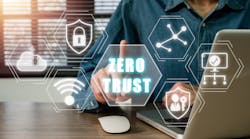The Digital Revolution: A journey from desktop to Cloud, secured by Zero Trust
The evolution of technology has dramatically reshaped our world, and one of the most significant transformations has occurred in the way we store, access, and process data. From the early days of storing everything on desktop computers to the cloud-based infrastructure of today, the journey has been marked by innovation and disruption.
In the early days of computing, data was primarily stored on individual desktop machines. This limited storage capacity made it difficult to share information across multiple users. Then came the servers, introducing a new era of efficiency and collaboration. They provided centralized storage and processing capabilities, significantly improving efficiency and collaboration and marking clear progress in technological advancements.
As the volume of data continued to grow, on-premise data centers emerged as a solution. These facilities housed servers, storage devices, and networking equipment, providing a dedicated environment for data management. However, on-premise data centers were often expensive to build and maintain, and they lacked the scalability and flexibility required to meet the demands of modern businesses.
Cloud Computing Creates a Technology Paradigm Shift
The advent of cloud computing marked a significant turning point in data storage and processing history. Cloud providers offer scalable and flexible infrastructure, empowering businesses to access computing resources on demand. This enables organizations to reduce costs, improves agility, and allows them to focus on their core competencies, fostering a sense of optimism and forward-thinking.
The shift from on-premise to cloud-based infrastructure has also profoundly impacted how we connect devices and networks. ERP systems were previously directly wired to individual machines, limiting connectivity and functionality. The invention of LANs (Local Area Networks) and WANs (Wide Area Networks) provided a more flexible and scalable way to connect devices and networks.
MPLS (Multiprotocol Label Switching) emerged as a key technology for connecting geographically dispersed networks. MPLS provides a more efficient and reliable way to transport data across networks, reducing latency and improving performance. In recent years, SD-WAN (Software-Defined Wide Area Network) has become a more flexible and cost-effective alternative to traditional WAN architectures.
Today, data is distributed across various environments, including on-premise data centers, cloud platforms, and PaaS (Platform as a Service) and IaaS (Infrastructure as a Service) offerings. This distributed landscape has created new opportunities for businesses but has also introduced new challenges in terms of security and management.
More Devices, More Threats
The proliferation of devices, applications, and data has created a much larger attack surface, making organizations vulnerable to various cyber threats. Ransomware attacks have become increasingly sophisticated and damaging, targeting critical infrastructure and businesses of all sizes.
To mitigate these risks, organizations must prioritize robust cybersecurity measures. One effective approach is to adopt a zero-trust architecture. This security model assumes that no device, user, or application should be trusted by default, regardless of location or origin. Instead, every access request is verified and authorized based on user identity, device health, and network context.
By implementing a zero-trust framework, organizations can significantly reduce their attack surface and improve their ability to detect and respond to threats. This approach is particularly important in today's distributed digital landscape, where data and applications are spread across multiple environments.
In addition to zero trust, organizations should also implement other cybersecurity best practices, such as:
- Regularly updating software and firmware: This helps to address vulnerabilities that attackers could exploit.
- Educating employees about cybersecurity best practices: This helps prevent human errors that can lead to security breaches.
- Investing in advanced threat detection and response technologies: This helps organizations proactively identify and address potential threats.
As the digital landscape evolves, individuals and businesses must stay informed about emerging threats and adopt proactive security measures. By doing so, we can harness technology's benefits while minimizing its risks.
Zero Trust and the Cloud
About the Author
Jaye Tillson
Jaye Tillson, Field CTO and Distinguished Technologist – Security at HPE, brings over 25 years of invaluable expertise in successfully implementing strategic global technology programs. With a keen focus on digital transformation, Jaye has been pivotal in guiding numerous organizations through their zero-trust journey, enabling them to flourish in today's dynamic digital landscape. (For more information, visit his website at https://jayetillson.tech/.)
Jaye is also the co-founder of the SSE Forum and co-host of its popular podcast, 'The Edge,' where he delves into topics such as cybersecurity, the role of the CISO, SASE, SSE, and Zero Trust. This platform allows him to engage with a wider audience, fostering meaningful discussions on industry trends and innovations. Additionally, Jaye actively contributes as a CSA Zero Trust Working Group member, a board member of the CSA UK Chapter, and an Advisor for Infosec.live.




